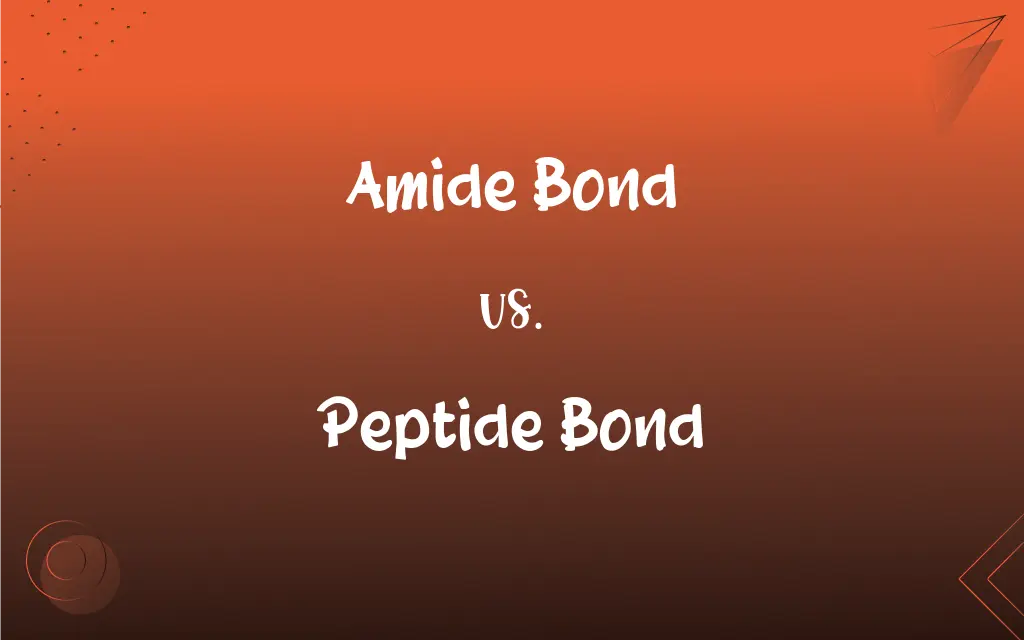Amide Bond vs. Peptide Bond: What's the Difference?
Edited by Aimie Carlson || By Harlon Moss || Published on June 24, 2024
An amide bond is a general type of bond formed between a carboxylic acid and an amine, while a peptide bond is a specific type of amide bond formed between the carboxyl group of one amino acid and the amino group of another in a protein.

Key Differences
An amide bond is a chemical bond formed between the carbonyl group of a carboxylic acid and the nitrogen atom of an amine. This bond is a key structural feature in various organic and biological molecules. A peptide bond, on the other hand, is a specific type of amide bond that occurs between the carboxyl group of one amino acid and the amino group of another amino acid, linking them together in a polypeptide chain.
The formation of an amide bond involves a condensation reaction, where water is released as a byproduct. This reaction can occur between various types of carboxylic acids and amines, leading to a wide range of amide compounds. In contrast, the formation of a peptide bond is a specialized case of amide bond formation, specifically occurring during protein synthesis, where amino acids are joined together to form proteins.
Amide bonds are found in many organic compounds, including polymers like nylon and proteins. They are characterized by their stability and resistance to hydrolysis. Peptide bonds, as a subset of amide bonds, are particularly important in biology, as they form the backbone of proteins, determining their structure and function.
The strength and stability of an amide bond make it a crucial linkage in various chemical and biological systems. Peptide bonds, while also strong and stable, have additional significance in biology due to their role in forming the primary structure of proteins, which is essential for their biological activity.
All peptide bonds are amide bonds, not all amide bonds are peptide bonds. The term "amide bond" refers to a broader category of chemical bonds, while "peptide bond" is used specifically to describe the bonds that link amino acids together in proteins.
ADVERTISEMENT
Comparison Chart
Definition
Bond between a carboxylic acid and an amine
Specific type of amide bond between amino acids
Occurrence
In various organic and biological molecules
Specifically in polypeptides and proteins
Reaction Type
Condensation reaction between acid and amine
Condensation reaction between amino acids
Biological Significance
Found in polymers, drugs, and proteins
Essential for protein structure and function
Scope
Broader category of chemical bonds
Subset of amide bonds specific to proteins
ADVERTISEMENT
Amide Bond and Peptide Bond Definitions
Amide Bond
A chemical bond formed between a carboxylic acid group and an amine group.
The amide bond in nylon gives it strength and durability.
Peptide Bond
A bond formed by a condensation reaction between the carboxyl group of one amino acid and the amino group of another.
The peptide bond in a polypeptide chain is formed through dehydration synthesis.
Amide Bond
A bond that is stable and resistant to hydrolysis under normal conditions.
The amide bond in proteins contributes to their structural stability.
Peptide Bond
A covalent bond formed during protein synthesis.
The peptide bond in insulin is crucial for its biological activity.
Amide Bond
A bond that involves the sharing of electrons between a carbonyl carbon and a nitrogen atom.
The amide bond in urea is an important feature of its molecular structure.
Peptide Bond
A bond that contributes to the primary structure of proteins.
The peptide bond in collagen provides structural support to tissues.
Amide Bond
A type of bond that is common in organic chemistry and biochemistry.
The amide bond in polyamides is responsible for their polymerization.
Peptide Bond
A linkage that is stable and resistant to breaking under physiological conditions.
The peptide bond in enzymes is essential for their catalytic function.
Amide Bond
A linkage characterized by a carbonyl group (C=O) adjacent to a nitrogen atom.
The amide bond in acetaminophen is crucial for its analgesic properties.
Peptide Bond
A specific type of amide bond that links amino acids in a protein.
The peptide bond between glycine and alanine forms a dipeptide.
FAQs
Are all peptide bonds amide bonds?
Yes, all peptide bonds are a specific type of amide bond.
What is an amide bond?
An amide bond is a chemical bond formed between a carboxylic acid group and an amine group.
What is a peptide bond?
A peptide bond is a specific type of amide bond that links amino acids together in a protein.
How is an amide bond formed?
An amide bond is formed through a condensation reaction between a carboxylic acid and an amine, releasing water.
How is a peptide bond formed?
A peptide bond is formed during protein synthesis when the carboxyl group of one amino acid reacts with the amino group of another, releasing water.
Why are peptide bonds important in proteins?
Peptide bonds are crucial in proteins because they form the backbone of the protein chain, determining its structure and function.
Are amide bonds easy to break?
Amide bonds are generally stable and resistant to hydrolysis under normal conditions.
Can amide bonds be found outside of proteins?
Yes, amide bonds are found in various organic compounds, including polymers and drugs, not just in proteins.
What is the difference in reactivity between amide bonds and peptide bonds?
The reactivity is generally similar, but the context matters; peptide bonds in proteins are specifically adapted to be stable in physiological conditions.
What role do amide bonds play in biology?
Amide bonds are important in biology for forming the structure of proteins and in the synthesis of other biological molecules.
Can peptide bonds be synthesized artificially?
Yes, peptide bonds can be synthesized artificially using techniques like solid-phase peptide synthesis to create peptides and proteins.
How are peptide bonds detected in protein analysis?
Peptide bonds can be detected using techniques like mass spectrometry and amino acid sequencing in protein analysis.
How are amide bonds used in drug design?
Amide bonds are often used in drug design to create molecules with specific therapeutic properties, taking advantage of their stability and structural diversity.
How do enzymes affect peptide bonds in proteins?
Enzymes like proteases can catalyze the hydrolysis of peptide bonds, breaking down proteins into smaller peptides or amino acids.
Are there any exceptions to the stability of peptide bonds in proteins?
Yes, certain chemical modifications or extreme conditions can lead to the cleavage of peptide bonds, but they are generally stable under physiological conditions.
How do peptide bonds contribute to protein structure?
Peptide bonds link amino acids together, forming the primary structure of proteins, which influences their overall shape and function.
Can amide bonds participate in hydrogen bonding?
Yes, the carbonyl and amine groups in an amide bond can participate in hydrogen bonding, contributing to the stability of structures like proteins.
What is the significance of the orientation of amide bonds in proteins?
The orientation of amide bonds in proteins affects the formation of secondary structures like alpha-helices and beta-sheets.
What factors can affect the stability of amide bonds?
Factors such as pH, temperature, and the presence of nucleophiles can affect the stability of amide bonds.
Can amide bonds be found in non-protein molecules?
Yes, amide bonds are also found in non-protein molecules like nylon and other synthetic polymers.
About Author
Written by
Harlon MossHarlon is a seasoned quality moderator and accomplished content writer for Difference Wiki. An alumnus of the prestigious University of California, he earned his degree in Computer Science. Leveraging his academic background, Harlon brings a meticulous and informed perspective to his work, ensuring content accuracy and excellence.
Edited by
Aimie CarlsonAimie Carlson, holding a master's degree in English literature, is a fervent English language enthusiast. She lends her writing talents to Difference Wiki, a prominent website that specializes in comparisons, offering readers insightful analyses that both captivate and inform.






































































